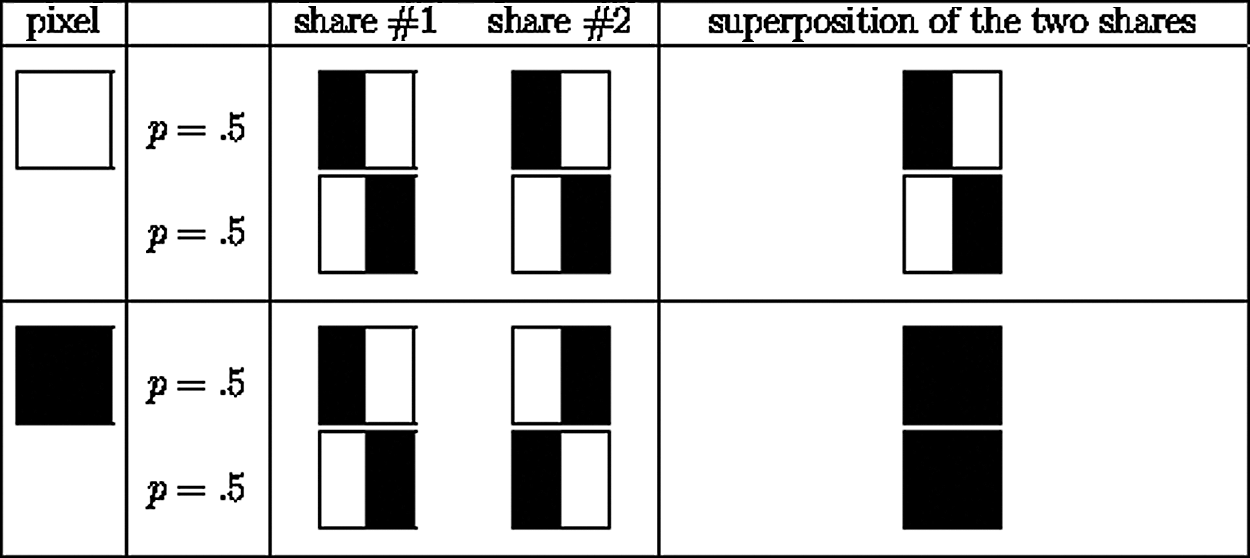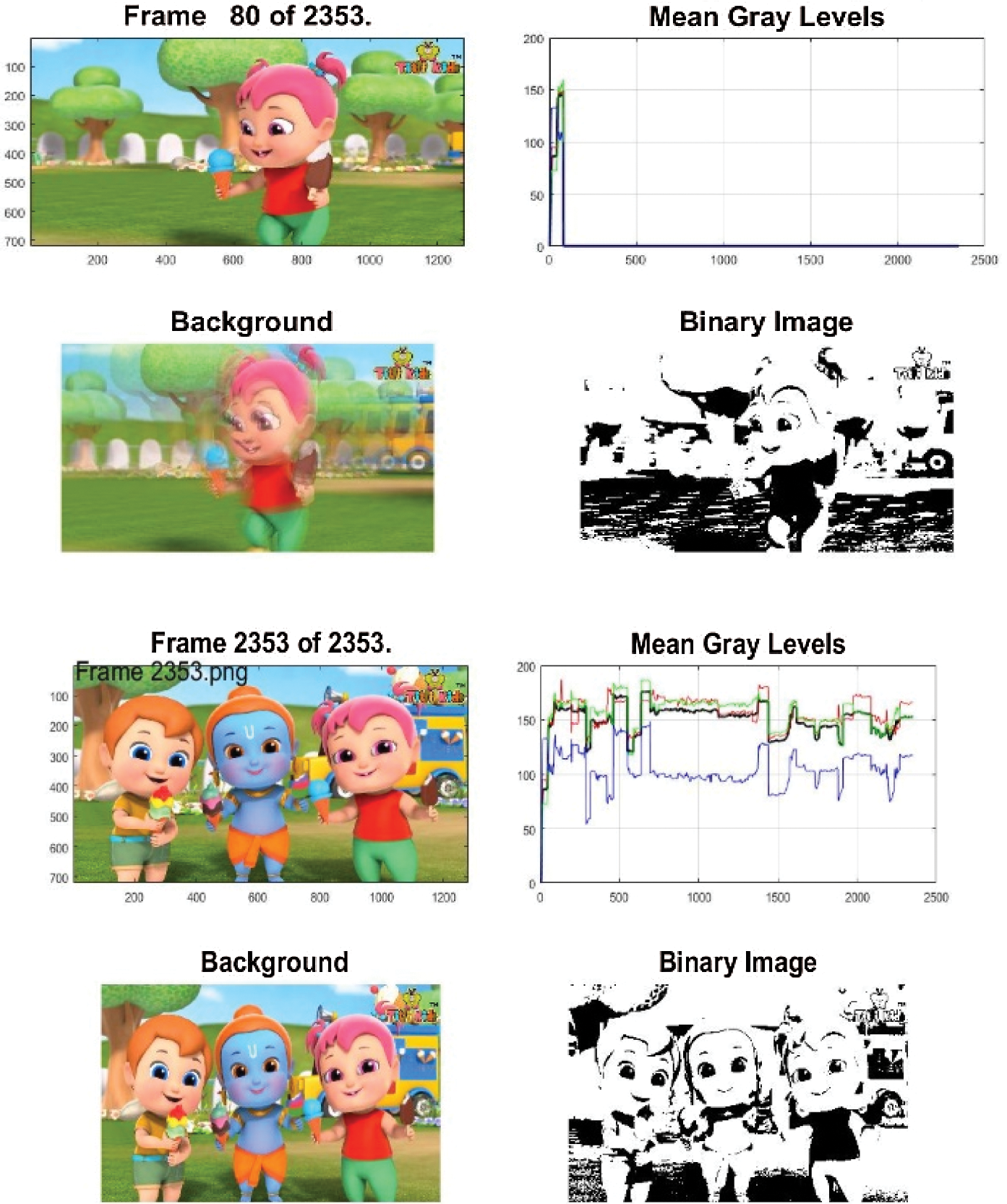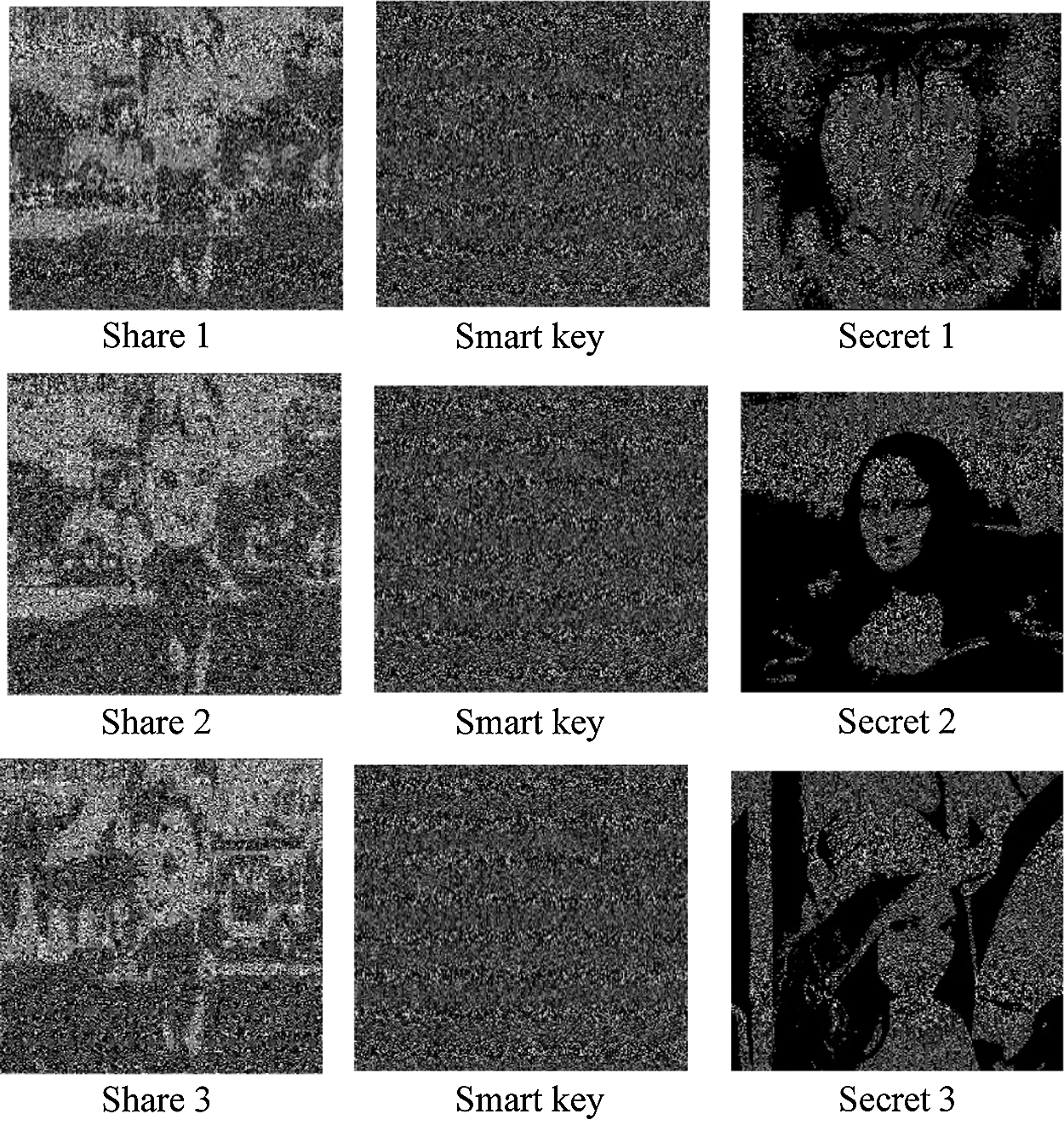DOI:10.32604/csse.2022.018597

| Computer Systems Science & Engineering DOI:10.32604/csse.2022.018597 |  |
| Article |
Video Identification Based on Watermarking Schemes and Visual Cryptography
1Department of Information Technology, Computers and Artificial Intelligence Helwan University, Cairo, Egypt
2Department of Information Technology, Computing Studies Arab Open University, Cairo, Egypt
3Department of Information Technology, Information Technology and Computer Science Sinai University, Ismailia, Egypt
*Corresponding Author: Maged Wafy. Email: maged.wafi@aou.edu.eg
Received: 13 March 2021; Accepted: 02 May 2021
Abstract: Related to the growth of data sharing on the Internet and the wide - spread use of digital media, multimedia security and copyright protection have become of broad interest. Visual cryptography (
Keywords: Visual cryptography (VC); video watermarking; PSNR
Visual cryptography (
Visual cryptography is interesting because decryption does not require a computer, but instead it is done by a human visual system. The image reconstructed by combining the shares of a qualified group of participants is not the same as the secret image. The hidden image pixels that were white are a lighter shade of grey than the black image pixels, and the contrast parameter is the difference between the darkness of the black and white pixels. Ideally, to make it easy to differentiate between black and white regions, we want a high contrast.
We suggest a new approach called smart key, an approach for hiding multiple images in video files. The method proposed is based on a (

Figure 1: a)
Our aim is to use
First, Naor and Shamir proposed visual cryptography [6].
In typical
There are limits to such previous techniques: they produce meaningless shares and are built on Boolean operations, [9,10] such as exclusive or (XOR) and bit shift operations, making it harder to physically decrypt secrets [11]. The proposed method, on the other hand, can encrypt many secret images in meaningful, physically realizable shares because it is built on the physical superimposition of transparency-printed share (smart key) on the video file corresponding to an AND function. Various approaches to hiding visual information in 2D images or 3D objects have recently been proposed. Shadow art, which casts multiple images of a sculpture on walls, was proposed by Mitra et al. [12]. A hidden image in
Usually, digital watermarks are used as a method to secure intellectual property rights (IPR). Watermarks are digital codes that typically contain various types of information about the owner or author and/or the destination of the data embedded in the original data [21]. In the simplest case, a watermark consists of another image or emblem that can be directly connected to the image owner; it is possible to determine the relationship between the watermark and the owner by storing the watermark in a Trusted Authority (TA) that may interfere in the event of a conflict.
To prevent attacks, the marks should be robust enough to avoid the deliberate or accidental removal and should not introduce distracting impact on the original data [22,23]. On the other hand, in certain situations, the embedded watermark can only be identified and manipulated by the selected receiver [24]. For other goals, such as data authentication, data monitoring and tracking, watermarking techniques have also been used. In the first example, [25] a fragile watermark is embedded in the original data so that any alteration that occurred during the transmission of the data can be detected; indeed, a fragile watermark has the characteristic that the embedding picture is very sensitive to minor change. In the second example, the tracking systems use watermarks to automatically detect broadcast data owners and pay the due royalties to them [26].
Indeed, some trade-offs and contradictory criteria include watermarking techniques. For example, the protection of the watermark is often connected to the imperceptibility of the embedding mechanism, but at the same time, watermarks should be sufficiently robust to be detected by the detection algorithm and resist many forms of attacks, ranging from geometric manipulation to compression [27].
The rapid growth of data presents new challenges in securing and managing digital content copyrights [28], making it possible to duplicate one of the facets of this digital data. Therefore, if the need for the hour in the new digital society is digital data, copyright security. Copyright security problems can be addressed by implementing watermarking techniques. The technique for watermarking must comply with the following properties:
• Robustness: Watermark’s durability from attack.
• Imperceptibility: The picture and initial image with the watermark must be indistinguishable from the human visual system (HVS).
• Security: It must be possible for the approved owner to be able to watermark elicitation.
• Blindness: For watermark extraction, the original image is not necessary.
• Multiple watermarking: In order to track the distribution of digital images, the possibility of adding several watermarks within the original data is often requested. The risk of crossing a latter watermark over a front watermark can, however, be avoided and multiple watermarking systems are usually complex and seek to resolve this weakness.
• Unambiguity: ownership of the image must be concluded by the extracted watermark.
2.3 Watermarking and Visual Cryptography
Usually, the created watermark is inserted directly into the image to be covered in watermarking schemes, in order to avoid violations and unauthorized distribution of the image. Typically, [29] the watermark is given as input to the VC scheme, obtaining a number of shares when a visual cryptographic scheme is used in combination. One of the shares is then used as a watermark and provided as an input to the watermarking algorithm’s embedding process, while the others are stored and covered. A number of actors are included in the standard scenario considered in the combined VC based watermarking scheme:
• the owner of the image who wishes to mark his or her own image and to prevent the use of the image without permission.
• the trusted authority (TA) which is involved in the scheme and whose involvement may be required to arbitrate the ownership of the image in the event of a dispute.
• finally, the attacker who wants to change and use the image and/or its watermark cheats on the possession of a stolen image.
2.4 Watermarking with (2,2) VC Scheme
The use of a (2, 2) VC scheme is the basis of most schemes combining watermarking with visual cryptography. Such VC schemes can be thought of as a private key cryptosystem, as stated in [30]. Indeed, two random-looking shares are encoded in the hidden printed message: one of the two shares can be freely distributed and used as a cipher text, while the other share plays the function of a secret key. By stacking all transparencies together, the original image is restored. The one-time pad is remembered by this method, as each ciphertext page is decoded by using a different transparency. The input image to the VC scheme is the watermark in combined watermarking schemes [31].
A possible extension of the previous model can be done by considering different kinds of VC schemes. As depicted in Fig. 2, by including a (2, n) VC scheme it is possible to split the watermark in multiple shares [32]. During the embedding phase, one of the shares will be stored by the image owner. The other shares will be passed to various trusted authorities. During the extraction process, the owner will contact one of the involved TA in the event of a dispute and will run the extraction phase as previously mentioned in the case (2, 2).
2.5 Watermarking with (k, n)-VC Scheme
It is possible to create VC schemes requiring that at least a number of k shares are combined to recreate the original picture [33]. In certain cases, the generation algorithm of the shares can be modified in order to build and allocate different shares to the participants [34], so that only a certain subset of participants in the scheme can recreate the secret image. In the latter case, in access systems, eligible subsets of participants are arranged. In both cases, by building on the previous proposed model, the merged schemes can be easily expanded, altering only the included VC scheme [35].
Another desirable aspect coming from the adoption of VC in the watermarking system is that it is possible to improve the robustness of the resulting system [36]. This discuss how to enhance the reconstruction of the embedded watermarking, considering that even in the presence of some errors [37], black areas in the original watermark (obtained by the superposition of the shares) are correctly reconstructed, that can be prompted by any noise on the transmission channel or inserted by the opponent maliciously [38,39].
We have suggested
In this section, we propose a VC scheme for multiple secret images in video, Visual cryptography is a scheme to hide a secret image using any number of shadow image called shares. The secret image should be a grayscale image or if color we need to convert it into grayscale. When we break the image into shares, they alone on themselves don’t look like anything but when they are layered on top of another, they return back the original image. The patterns shown in Fig. 2, are used by this particular algorithm used in this paper. If the same patterns are stacked on top of another pattern, they return the same pattern and give a black image if the opposite patterns are used. In the algorithm, the trick is the way the shares are created.
In our implementation we perform a slightly modified visual cryptographic scheme in which the image to be hidden is divided into shares in such a way that two totally different seemingly innocent images are displayed as a partially blurred image. But when we combine them, they reveal the original to-be-hidden image.

Figure 2: Shows how each pixel is divided into 4 parts and then the sub-part’s colour arrangement is changed to either allow partial amount of light to pass or nothing at all
Encryption is the method of using an algorithm to convert information to make it unreadable to everyone but those who have the key to decrypt it as in Fig. 3.
Decryption is the mechanism by which an algorithm requires a key to decode the message to retrieve the original message from a cipher document as shown in Fig. 4.
After using all the stored frames to create a video file with of stored decrypted image as an individual frame of the video, the outcome is obtained.

Figure 3: Video after Encryption

Figure 4: Video after Decryption

Figure 5: Proposed system model
For
Steps of Generation Shares:
1) Choose n images.
2) Load images in grayscale mode.
3) Check all images have equal size.
4) Convert grayscale images to binary.
5) Create new black images twice as big as old ones.
6) Coordinates of pixels in new images corresponding to the original ones.
7) Permute positions as shown in Fig. 2.
8) Create an image that would show what the hidden image.
9) Save all images.
10) with white pixels corresponding to transparent.
A key is a piece of information that specifies a visual cryptography algorithm’s functional performance. The algorithm would be useless without a key. A key determines the specific transformation of plain text into cipher text in the case of encryption, or vice versa during decryption. In our model, we proposed only one (smart key) to decrypt multiple secret images by the video file as shown in Fig. 6.

Figure 6: Smart Key (common share)
4 Experimental Results & Discussion
Via multiple attacks, such as brute-force attacks and statistical attacks, a successful encryption method should be secure. Based on different analyses, this section proves the efficacy of the proposed algorithm. For binary and grayscale images, we have applied the proposed method. Fig. 7 display the results of EVCS.

Figure 7: Results of our proposed EVCS, input images are
Statistical Analysis
Against any type of statistical attacks, a perfect cipher should be robust. Different statistical studies have been performed on the proposed algorithm, including histogram analysis, pixel difference measurement, correlation of pixels and entropy to prove their robustness.
The histogram is a graph that displays the number of pixels in an image at each different value of the intensity contained in that image. The histograms of random frames of original shares and encrypted shares have been measured and analyzed. The frame from the hidden video and the smart key are shown in Fig. 8.

Figure 8: Histogram analysis
4.2 Pixel Difference Measurement
The two-error metrics used to compare image compression efficiency are the Mean Square Error (MSE) and the Peak Signal to Noise Ratio (PSNR) as shown in Tab. 1. The cumulative square error between the compressed image and the original image is represented by the MSE as in (1), while the PSNR is a peak error measure is defined as in (2).
Here, the maximum possible pixel value of the image is

4.3 Correlation Coefficient Analysis
A correlation is a statistical measurement of the two-variable relationship. The measure is best used for variables that display a linear relation with each other. You can visually reflect the fit of the data in a scatterplot. We may usually analyze the relationship between the variables using a scatterplot to assess whether or not they are correlated. Using the following formula, as shown in Tab. 2 the correlation coefficient indicating the intensity of the relationship between two variables can be found in (3):
where:
A value that shows the strength of the relationship between variables is the correlation coefficient. All values from −1 to 1. can be taken from the coefficient. The values’ meanings are:

It shows the data’s randomness. We can get the ideal H = 8 according to the given equation as in (4), which shows that the information is random. Therefore, after encryption, the data entropy of the encrypted image should be close. The closest it gets to 8, the less data disclosure is necessary for the cryptosystem as in Tab. 3.

Secure and safe online phishing attacks are supported by the proposed approach. As the visual cryptography technique is implemented on a random image chosen for each new server-under-test, this approach ensures further security.
We also introduced smart keys, a VCS that utilizes common shares. k Depending on a given share, we can decrypt many secret images in video simultaneously with the common shares. Smart key in meaningful shares cover hidden images and can be added to binary, grayscale, and color images.
Funding Statement: The authors received no specific funding for this study.
Conflicts of Interest: The authors declare that they have no conflicts of interest to report regarding the present study.
1. Y. Cheng, Z. Fu and B. Yu, “Improved visual secret sharing scheme for QR code applications,” IEEE Transactions on Information Forensics and Security, vol. 13, no. 9, pp. 2393–2403, 2018. [Google Scholar]
2. H. C. Chao and T. Y. Fan, “Random-grid based progressive visual secret sharing scheme with adaptive priority,” Digital Signal Processing, vol. 68, pp. 69–80, 2017. [Google Scholar]
3. S. Lu Wan, X. Y. Yan, Y. Wang and C. Chang, “Visual secret sharing scheme for (k, n) threshold based on QR code with multiple decryptions,” Journal of Real-Time Image Processing, vol. 14, no. 1, pp. 25–40, 2018. [Google Scholar]
4. K. Praveen and M. Sethumadhavan, “On the extension of XOR step construction for optimal contrast grey level visual cryptography,” Int. Conf. on Advances in Computing, Communications and Informatics (ICACCI). IEEE, vol. 49, pp. 219–222, 2017. [Google Scholar]
5. B. Yan, Y. Xiang and G. Hua, “Improving the visual quality of size-invariant visual cryptography for grayscale images: An analysis-by-synthesis (AbS) approach,” IEEE Transactions on Image Processing, vol. 28, no. 2, pp. 896–911, 2018. [Google Scholar]
6. M. Naor and A. Shamir, “Visual cryptography, EUROCRYPT’94,” Lecture Notes in Computer Science, vol. 950, pp. 112, 1995. [Google Scholar]
7. A. Shamir, “How to share a secret,” Communications of the ACM 22, pp. 612–613,1979. [Google Scholar]
8. B. Liu, R. R. Martin, J. W. Huang and S. M. Hu, “Structure aware visual cryptography,” Computer Graphics Forum, vol. 33, no. 7, pp. 141–150, 2014. [Google Scholar]
9. X. Yan and Y. Lu, “Progressive visual secret sharing for general access structure with multiple decryptions,” Multimedia Tools and Applications, vol. 77, no. 2, pp. 2653–2672, 2018. [Google Scholar]
10. H. C. Chao and T. Y. Fan, “XOR-based progressive visual secret sharing using generalized random grids,” Displays, vol. 49, pp. 6–15, 2017. [Google Scholar]
11. F. Liu and W. Q. Yan, Visual cryptography for image processing and security. Theory, Methods, and Applications. Springer International publishing, pp. 83–129, 2014. [Google Scholar]
12. N. J. Mitra and M. Pauly, “Shadow art,” ACM Transactions on Graphics, vol. 28, no. 5, pp. 1–12,2009. [Google Scholar]
13. B. Yan, Y. F. Wang, L. Y. Song and H. M. Yang, “Size-invariant extended visual cryptography with embedded watermark based on error diffusion,” Multimedia Tools and Applications, vol. 75, pp. 11157–11180, 2016. [Google Scholar]
14. V. L. Narayana and A. P. Gopil, “Visual cryptography for gray scale images with enhanced security mechanisms,” Traitement du Signal, vol. 34, pp. 197–208, 2017. [Google Scholar]
15. W. Qiao, H. Yin and H. Liang, “A kind of visual cryptography scheme for color images based on halftone technique,” in Int. Conf. on Measuring Technology and Mechatronics Automation, IEEE, vol.1,2009. [Google Scholar]
16. K. Shankar and P. Eswaran, “ECC based image encryption scheme with aid of optimization technique using differential evolution algorithm,” Int J Appl Eng Res, vol. 10, no. 55, pp. 1841–1845, 2015. [Google Scholar]
17. K. Shankar and P. Eswaran, “Sharing a secret image with encapsulated shares in visual cryptography,” Procedia Computer Science, vol. 70, pp. 462–468, 2015. [Google Scholar]
18. H. Liu and X. Wang, “Color image encryption using spatial bit-level permutation and high-dimension Chaotic system,” Optics Communications, vol. 284, no. 17, pp. 3895–3903, 2011. [Google Scholar]
19. B. Shrivas and S. Yadav, “Visual cryptography in the video using halftone technique,” International Journal of Computer Applications, vol. 117, no. 14, pp. 19–22, 2015. [Google Scholar]
20. G. G. Bulut, M. C. Catalbas and H. Guler, “Chaotic systems based real-time implementation of visual cryptography using LabVIEW,” Traitement du Signal, vol. 37, no. 4, pp. 639–645, 2020. [Google Scholar]
21. A. H. Allaf and M. A. Kbir, “A review of digital watermarking applications for medical image exchange security,” in The proc. of the third int. conf. on smart city applications, Cham: Springer, 2018. [Google Scholar]
22. Z. Li, H. Tian, Y. Xiao, Y. Tang and A. Wang, “An error-correcting code based robust watermarking scheme for stereolithographic files,” Computer Systems Science and Engineering, vol. 37, no. 2, pp. 247–263, 2021. [Google Scholar]
23. Z. Meng, T. Morizumi, S. Miyata and H. Kinoshita, “Design scheme of copyright management system based on digital watermarking and blockchain,” in IEEE 42nd Annual Computer Software and Applications Conf. (COMPSACvol. 2, 2018. [Google Scholar]
24. F. N. Al-Wesabi, S. Alzahrani, F. Alyarimi, M. Abdul, N. Nemri et al., “A reliable NLP scheme for english text watermarking based on contents interrelationship,” Computer Systems Science and Engineering, vol. 37, no. 3, pp. 297–311, 2021. [Google Scholar]
25. X. Gong, L. Chen, F. Yu, X. Zhao and S. Wang, “A secure image authentication scheme based on dual fragile watermark,” Multimedia Tools and Applications, vol. 79, no. 25, pp. 18071–18088, 2020. [Google Scholar]
26. X. Jiang, Z. Lu and X. Ding, “A semi-fragile blind watermarking scheme for color images based on visual cryptography and discrete cosine transform,” International Journal of Innovative Computing, Information and Control, vol. 13, no. 5, pp. 1709–1719, 2017. [Google Scholar]
27. J. Saturwar and D. N. Chaudhari, “Secure visual secret sharing scheme for color images using visual cryptography and digital watermarking,” Journal of Engineering Sciences, vol. 9, no. 6, pp. 1–4, 2018. [Google Scholar]
28. A. Fatahbeygi and F. A. Tab, “A highly robust and secure image watermarking based on classification and visual cryptography,” Journal of information security and applications, vol. 45, pp. 71–78, 2019. [Google Scholar]
29. B. P. Devi, K. M. Singh and S. Roy, “New copyright protection scheme for digital images based on visual cryptography,” IETE Journal of Research, vol. 63, no. 6, pp. 870–880, 2017. [Google Scholar]
30. S. Jiao, J. Feng, Y. Gao, T. Lei and X. Yuan, “Visual cryptography in single-pixel imaging,” Optics express, vol. 28, no. 5, pp. 7301–7313, 2020. [Google Scholar]
31. J. H. Saturwar and D. N. Chaudhari, “Review of models, issues and applications of digital watermarking based on visual cryptography,” in Int. Conf. on Inventive Systems and Control (ICISCIEEE, 2017. [Google Scholar]
32. S. D. Degadwala and S. Gaur, “4-share VCS based image watermarking for dual RST attacks,” Computational Vision and Bio Inspired Computing. Cham: Springer, pp. 902–912,2018. [Google Scholar]
33. W. Chen, X. Li, S. Zhan and D. Niu, “Multimedia video watermarking algorithm using SVD and secret sharing,” in 2nd IEEE Advanced Information Management, Communicates, Electronic and Automation Control Conf. (IMCECIEEE, 2018. [Google Scholar]
34. R. R. Kishore, “Digital watermarking based on visual cryptography and histogram,” International Journal of Computer and Information Engineering, vol. 10, no. 7, pp. 1264–1269, 2016. [Google Scholar]
35. J. Saturwar and D. N. Chaudhari, “Secure visual secret sharing scheme for color images using visual cryptography and digital watermarking,” in Second Int. Conf. on Electrical, Computer and Communication Technologies (ICECCTIEEE, 2017. [Google Scholar]
36. T. E. Jisha and T. Monoth, “Authenticity and integrity enhanced active digital image forensics based on visual cryptography, Smart Intelligent Computing and Applications,” Singapore: Springer, pp. 189–196,2019. [Google Scholar]
37. N. Shashni and M. Yadav, “Cryptanalysis on digital image watermarking based on feature extraction and visual cryptography,” Progress in Advanced Computing and Intelligent Engineering. Singapore: Springer, pp. 425–435,2019. [Google Scholar]
38. K. N. Kaur, I. Gupta and A. K. Singh, “Digital image watermarking using (2, 2) visual cryptography with DWT-SVD based watermarking,” Computational intelligence in data mining. Singapore: Springer, pp. 77–86,2019. [Google Scholar]
39. A. Surve , “Visual cryptography and image processing based approach for bank security applications,” Second International Conference on Computer Networks and Communication Technologies, ICCNCT, Springer Nature, 2019. [Online]. Available: Visual Cryptography and Image Processing Based Approach for Bank Security Applications | SpringerLink. [Google Scholar]
 | This work is licensed under a Creative Commons Attribution 4.0 International License, which permits unrestricted use, distribution, and reproduction in any medium, provided the original work is properly cited. |